Effect of Thermal Exposure on Oil Shale Saturation and Reservoir Properties
Abstract
1. Introduction
2. Materials and Methods
2.1. Materials
2.2. Combustion Tube
2.3. Methods
2.3.1. Rock Characterization
2.3.2. NMR Relaxometry
2.3.3. Rock-Eval Pyrolysis
2.3.4. Scanning Electron Microscopy
3. Results
3.1. Gas Porosity and Permeability after Thermal Exposure
3.2. Investigation of the Porous Structure by SEM
3.3. Development of the T1–T2 Interpretation Scheme
3.4. NMR Analysis
3.5. OM Characterization by Rock-Eval Pyrolysis
4. Discussion
5. Conclusions
- The gas pressure-decay technique revealed a significant increase of porosity (on average, for 9 abs. % of porosity) and permeability (on average, for 1 mD) of core samples after the CT experiment. Samples located in high-temperature zones showed a direct correlation between the measured parameter and the combustion temperature. However, the changes were also conditioned by the initial properties of the core plugs, such as rock lithology and OM properties.
- The NMR T1–T2 fluid identification scheme was proposed by the results of preliminary research conducted on five core samples with a similar lithological type and reservoir properties. We applied the proposed scheme in the analysis of the T1–T2 maps obtained for samples before and after combustion. Interpretation of the maps allowed us to categorize the total fluid saturation into several fluid types (bitumen and adsorbed oil, structural and adsorbed water, and mobile oil in inorganic porosity) and estimate the changes induced by thermal exposure.
- Rock-Eval pyrolysis was performed in 1D and 2D testing modes, which elicited detailed knowledge on combustion front propagation inside the core plugs from different combustion tube zones. 2D pyrolysis technique demonstrated the relatively uniform distribution of OM inside the core plugs after CT. In addition, values of S0 and S1 indicated a certain amount of oil remaining in rock samples. We explain it as newly generated synthetic oil, which was trapped in the pores due to hindered migration in low-permeability rock. It can lead to the inaccurate interpretation of laboratory-scale combustion experiments involving crushed rock samples since a significant amount of generated oil remains in the core material and is not accounted for in the final material balance.
- SEM of rock samples revealed that heating of the organic-rich shales leads to at least two processes: the transformation of OM during the heating with the formation of new voids and the formation of micro and nanofractures in the mineral matrix. All these alterations increase the porosity and homogeneity of pores distribution in the rock.
- NMR T2 results included the determination of fluid saturation of the sample, as well as the pore size distribution before and after the combustion experiment. For low-permeability samples, NMR and Rock-Eval pyrolysis proved to be useful and reliable tools in determining the saturation of fragile core plugs and types of hydrocarbons in the rock, which can be applied in the assessment of the amount of displaced oil. In turn, conventional porosimetry also demonstrated satisfactory results in the estimation of open porosity and permeability of the rock.
Author Contributions
Funding
Acknowledgments
Conflicts of Interest
Appendix A. Combustion Tube Test Details
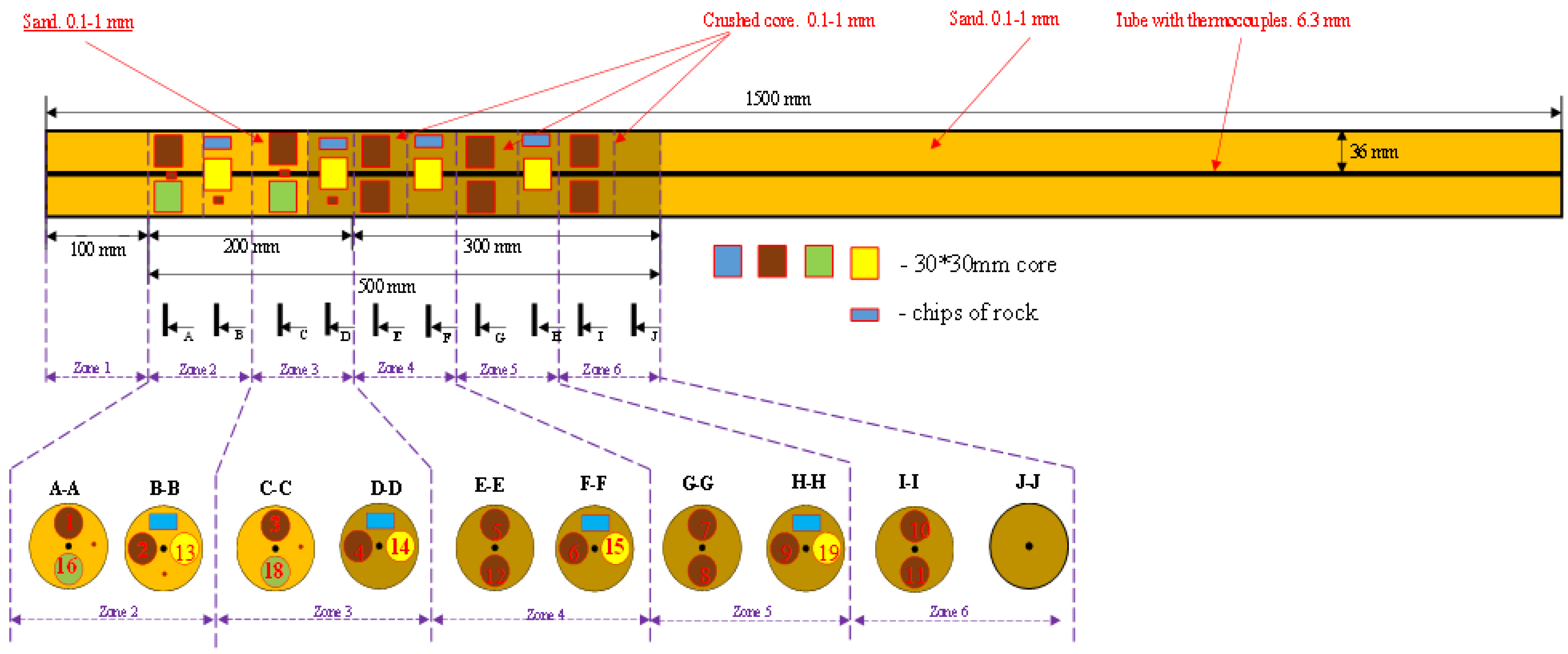
- Nitrogen was injected through the vertical combustion tube at a pressure of 8 MPa with a volumetric flow rate of 2.4 L/min, while the tube was heated by zones until it reached the specified temperature regime.
- After the combustion tube reached the specified temperature regime, the air injection began with a volumetric flow rate of 2.4 L/min.
- With a predetermined frequency, samples of the displaced fluid and gas samples were probed at the outlet of the combustion tube in order to determine the content of carbon dioxide, carbon monoxide, nitrogen, hydrogen sulfide, and hydrocarbon gases. According to the temperature logs, the propagation of the combustion front along the tube was recorded.
- At the final stage of the experiment, the external heating was turned off in order to stop the generation of hydrogen sulfide inside the tube.
- Rock samples were extracted from each section of the tube for further research. The air supply was stopped when the oil combustion front reached Section 5. Thus, the samples in CT section were not exposed to high temperatures.
Appendix B


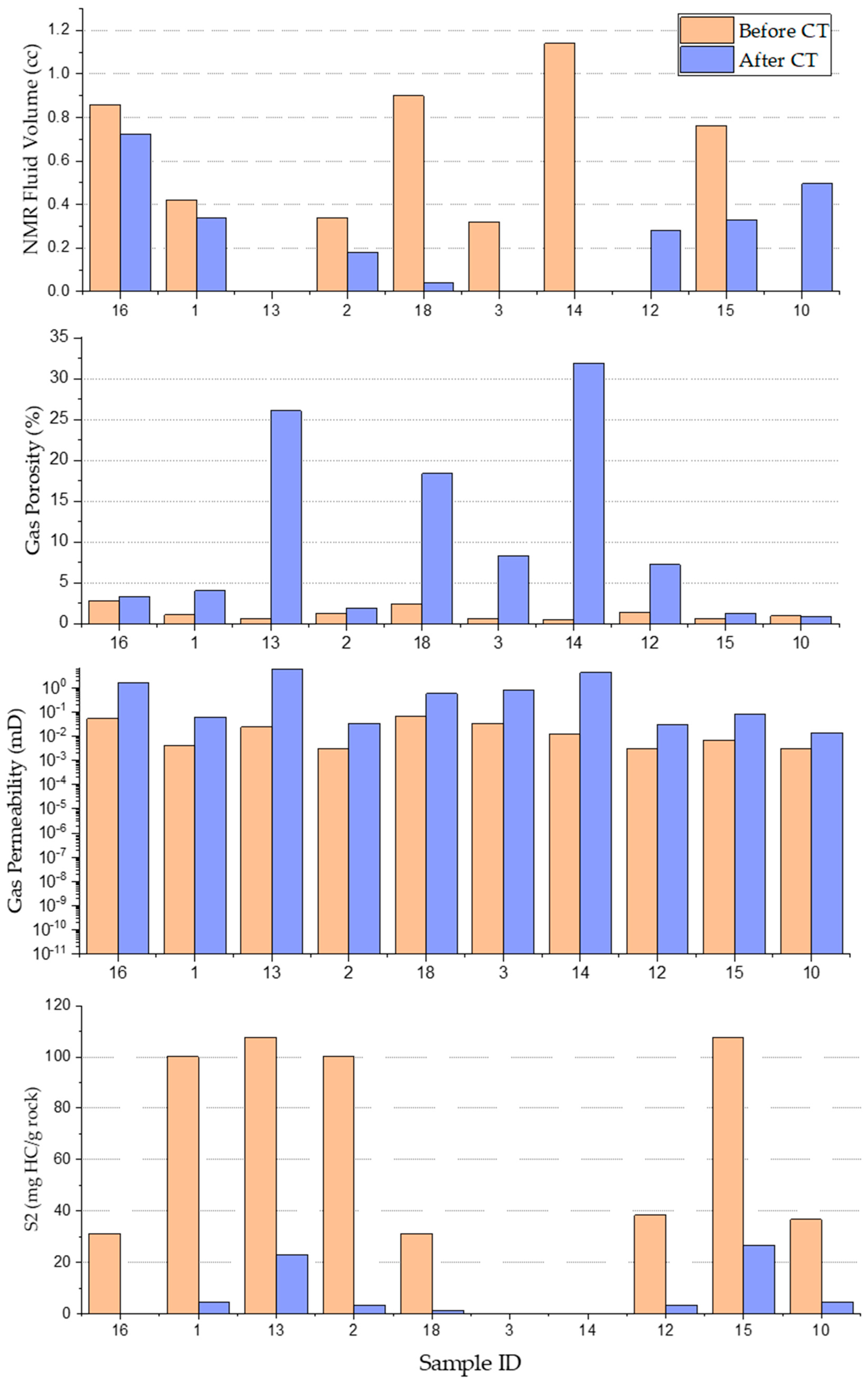
References
- Ahmed, U.; Nathan, M. Unconventional Oil and Gas Resources; CRC Press: Boca Raton, FL, USA, 2016; Volume 894. [Google Scholar]
- Lopatin, N.V.; Zubairaev, S.L.; Kos, I.M.; Emets, T.P.; Romanov, E.A.; Malchikhina, O.V. Unconventional Oil Accumulations in the Upper Jurassic Bazhenov Black Shale Formation, West Siberian Basin: A Self-Sourced Reservoir System. J. Petrol. Geol. 2003, 26, 225–244. [Google Scholar] [CrossRef]
- Kusskra, V.; Stevens, S.H.; Moodhe, K.D. Technically Recoverable Shale Oil and Shale Gas Resources: An Assessment of 137 Shale Formations in 41 Countries Outside the United States. Available online: https://www.eia.gov/analysis/studies/worldshalegas/pdf/overview.pdf?zscb=79906188 (accessed on 15 October 2020).
- Alvarado, V.; Manrique, E. Enhanced Oil Recovery: An Update Review. Energies 2010, 3. [Google Scholar] [CrossRef]
- Sheng, J.J. Critical Review of Field EOR Projects in Shale and Tight Reservoirs. J. Petrol. Sci. Eng. 2017, 159, 654–665. [Google Scholar] [CrossRef]
- Moore, R.G.; Mehta, S.A.; Ursenbach, M.G. A Guide to High Pressure Air Injection (HPAI) Based Oil Recovery. In Proceedings of the SPE/DOE Improved Oil Recovery Symposium, Tulsa, OK, USA, 13–17 April 2002; p. 7. [Google Scholar]
- Sarathi, P.S. In-situ Combustion Handbook-Prinicples and Practices; National Petroleum Technology Office. U.S. Department of Energy: Tulsa, OK, USA, 1999. [Google Scholar]
- Gutierrez, D.; Moore, R.G.; Ursenbach, M.G.; Mehta, S.A. The ABCs of In-Situ-Combustion Simulations: From Laboratory Experiments to Field Scale. J. Can. Petrol. Technol. 2012, 51, 256–267. [Google Scholar] [CrossRef]
- Kibodeaux, K.R. Evolution of Porosity, Permeability, and Fluid Saturations During Thermal Conversion of Oil Shale. In Proceedings of the SPE Annual Technical Conference and Exhibition, Amsterdam, The Netherlands, 27–29 October 2014; p. 22. [Google Scholar]
- Bai, F.; Sun, Y.; Liu, Y.; Guo, M. Evaluation of the Porous Structure of Huadian Oil Shale During Pyrolysis Using Multiple Approaches. Fuel 2017, 187, 1–8. [Google Scholar] [CrossRef]
- Sun, L.; Tuo, J.; Zhang, M.; Wu, C.; Wang, Z.; Zheng, Y. Formation and Development of the Pore Structure in Chang 7 Member Oil-shale from Ordos Basin during Organic Matter Evolution Induced by Hydrous Pyrolysis. Fuel 2015, 158, 549–557. [Google Scholar] [CrossRef]
- Geng, Y.; Liang, W.; Liu, J.; Cao, M.; Kang, Z. Evolution of Pore and Fracture Structure of Oil Shale under High Temperature and High Pressure. Energy Fuels 2017, 31, 10404–10413. [Google Scholar] [CrossRef]
- Kobchenko, M.; Panahi, H.; Renard, F.; Dysthe, D.K.; Malthe-Sørenssen, A.; Mazzini, A.; Scheibert, J.; Jamtveit, B.; Meakin, P. 4D Imaging of Fracturing in Organic-Rich Shales during Heating. J. Geophys. Res. Solid Earth 2011, 116. [Google Scholar] [CrossRef]
- Panahi, H.; Kobchenko, M.; Renard, F.; Mazzini, A.; Scheibert, J.; Dysthe, D.; Jamtveit, B.; Malthe-Sørenssen, A.; Meakin, P. A 4D Synchrotron X-Ray-Tomography Study of the Formation of Hydrocarbon-Migration Pathways in Heated Organic-Rich Shale. SPE J. 2013, 18, 366–377. [Google Scholar] [CrossRef]
- Saif, T.; Lin, Q.; Singh, K.; Bijeljic, B.; Blunt, M.J. Dynamic Imaging of Oil Shale Pyrolysis using Synchrotron X-ray Microtomography. Geophys. Res. Lett. 2016, 43, 6799–6807. [Google Scholar] [CrossRef]
- Tiwari, P.; Deo, M.; Lin, C.L.; Miller, J.D. Characterization of Oil Shale Pore Structure Before and After Pyrolysis by Using X-ray Micro CT. Fuel 2013, 107, 547–554. [Google Scholar] [CrossRef]
- Birdwell, J.E.; Lewan, M.D.; Miller, M. Geochemical Changes and Fracture Development in Woodford Shale Cores Following Hydrous Pyrolysis under Uniaxial Confinement. In Proceedings of the SPE/AAPG/SEG Unconventional Resources Technology Conference, Denver, CO, USA, 12–14 August 2013; p. 8. [Google Scholar]
- Lewan, M.D.; Birdwell, J.E. Application of Uniaxial Confining-core Clamp with Hydrous Pyrolysis in Petrophysical and Geochemical Studies of Source Rocks at Various Thermal Maturities. In Proceedings of the SPE/AAPG/SEG Unconventional Resources Technology Conference, Denver, CO, USA, 12–14 August 2013; p. 8. [Google Scholar]
- Washburn, K.E.; Birdwell, J.E.; Lewan, M.D.; Miller, M. Changes in Porosity and Organic Matter Phase Distribution Monitored by NMR Relaxometry Following Hydrous Pyrolysis Under Uniaxial Confinement. In Proceedings of the SPE/AAPG/SEG Unconventional Resources Technology Conference, Denver, CO, USA, 12–14 August 2013; p. 7. [Google Scholar]
- Liu, Z.; Yang, D.; Hu, Y.; Zhang, J.; Shao, J.; Song, S.; Kang, Z. Influence of In Situ Pyrolysis on the Evolution of Pore Structure of Oil Shale. Energies 2018, 11, 755. [Google Scholar] [CrossRef]
- Tisot, P.R. Alterations in Structure and Physical Properties of Green River Oil Shale by Thermal Treatment. J. Chem. Eng. Data 1967, 12, 405–411. [Google Scholar] [CrossRef]
- Deng, S.; Wang, Z.; Gu, Q.; Meng, F.; Li, J.; Wang, H. Extracting Hydrocarbons from Huadian Oil Shale by Sub-critical Water. Fuel Proc. Technol. 2011, 92, 1062–1067. [Google Scholar] [CrossRef]
- Sander, R.; Pan, Z.; Connell, L.D. Laboratory Measurement of Low Permeability Unconventional Gas Reservoir Rocks: A Review of Experimental Methods. J. Natural Gas Sci. Eng. 2017, 37, 248–279. [Google Scholar] [CrossRef]
- Simpson, G.A.; Fishman, N.S. Unconventional Tight Oil Reservoirs: A Call For New Standardized Core Analysis Workflows And Research. In Proceedings of the International Symposium of the Society of Core Analysts, St. John’s, NL, Canada, 16–21 August 2015. [Google Scholar]
- Guidry, K.; Luffel, D.; Curtis, J. Development of Laboratory and Petrophysical Techniques for Evaluating Shale Reservoirs; Gas Technology Institite: Des Plaines, IL, USA, 1996; p. 304. [Google Scholar]
- Straley, C.; Rossini, D.; Vinegar, H.J.; Tutunjan, P.; Morriss, C.E. Core Analysis by Low-Field NMR. Log Anal. 1997, 38, 84–94. [Google Scholar]
- Liu, Z.; Liu, D.; Cai, Y.; Yao, Y.; Pan, Z.; Zhou, Y. Application of Nuclear Magnetic Resonance (NMR) in Coalbed Methane and Shale Reservoirs: A review. Int. J. Coal Geol. 2020, 218, 103261. [Google Scholar] [CrossRef]
- Fleury, M.; Romero-Sarmiento, M.-F. Characterization of Shales Using T1–T2 NMR Maps. J. Petrol. Sci. Eng. 2015, 137. [Google Scholar] [CrossRef]
- Camp, W.K. Electron Microscopy of Shale Hydrocarbon Reservoirs. In AAPG Memoir 102; American Association of Petroleum Geologists: Tulsa, OK, USA, 2013. [Google Scholar]
- Ţălu, Ş. Micro and Nanoscale Characterization of Three Dimensional Surfaces: Basics and Applications; Napoca Star: Cluj, Romania, 2015. [Google Scholar]
- Popov, E.; Bondarenko, T.; Dobrovolskaya, S.; Kalmykov, A.; Morozov, N.; Erofeev, A. The Potential of Tertiary Methods Application for Unconventional Hydrocarbon Systems Exposure on the Example of Bazhenov Formation. OIl Ind. 2017, 54–57. [Google Scholar] [CrossRef]
- Khakimova, L.; Bondarenko, T.; Cheremisin, A.; Myasnikov, A.; Varfolomeev, M. High Pressure Air Injection Kinetic Model for Bazhenov Shale Formation Based on a set of oxidation studies. J. Petrol. Sci. Eng. 2019, 172, 1120–1132. [Google Scholar] [CrossRef]
- Popov, E.; Kalmykov, A.; Cheremisin, A.; Bychkov, A.; Bondarenko, T.; Morozov, N.; Karpov, I. Laboratory Investigations of Hydrous Pyrolysis as Ternary Enhanced Oil Recovery Method for Bazhenov Formation. J. Petrol. Sci. Eng. 2017, 156, 852–857. [Google Scholar] [CrossRef]
- Prishchepa, O.M.; Averianova, O.Y.; Ilyinskiy, A.A.; Morariu, D. Tight Oil and Gas Formations-Russia’s Hydrocarbons Future Resources; VNIGRI: Saint-Petersburg, Russia, 2014. [Google Scholar]
- Zhirong Zhang, J.K.V.; Paul, F.G.; Wenxuan, H.; Jianzhong, Q.; Tenger, B.; Changbo, Z.; Weixin, L. Flash Pyrolysis of Kerogens from Algal Rich Oil Shales from the Eocene Huadian Formation, NE China. Organ. Geochem. 2014, 76, 167–172. [Google Scholar] [CrossRef]
- Bondarenko, T.; Popov, E.; Cheremisin, A.; Kozlova, E.; Karpov, I.; Morozov, N. Laboratory Modeling of High-Pressure Air injection in Oil Fields of Bazhenov formation. OIl Ind. 2017, 3, 34–39. [Google Scholar] [CrossRef]
- Bondarenko, T. Evaluation of High-Pressure Air Injection Potential for In-Situ Synthetic Oil Generation from Oil Shale: Bazhenov Formation; Skolkovo Institute of Science and Technology: Moscow, Russia, 2018. [Google Scholar]
- Kontorovich, A.E.; Moskvin, V.I.; Bostrikov, O.I.; Danilova, V.P.; Fomin, A.N.; Fomichev, A.S.; Kostyreva, E.A.; Melenevsky, V.N. Main Oil Source Formations of the West Siberian Basin. Petrol. Geosci. 1997, 3, 343–358. [Google Scholar] [CrossRef]
- Lazar, O.R.; Bohacs, K.M.; Schieber, J.; Macquaker, J.H.; Demko, T.M. Mudstone Primer: Lithofacies Variations, Diagnostic Criteria, and Sedimentologic-Stratigraphic Implications at Lamina to Bedset Scales; SEPM (Society for Sedimentary Geology): Tulsa, OK, USA, 2015. [Google Scholar]
- Balushkina, N.S.; Kalmykov, G.A.; Belokhin, V.S.; Khamidullin, R.A.; Korost, D.V. Siliceous Reservoirs of the Bazhenov Formation, the Sredny Nazym Oil Field, and the Structure of Their Pore Space. Moscow Univ. Geol. Bull. 2014, 69, 91–100. [Google Scholar] [CrossRef]
- Khamidullin, R.R.; Kalmykov, G.A.; Korost, D.V.; Balushkina, N.S.; Bakay, A.I. Reservoir Properties of the Bazhenov Formation. In Proceedings of the SPE Russian Oil and Gas Exploration and Production Technical Conference and Exhibition, Moscow, Russia, 16–18 October 2012; p. 11. [Google Scholar]
- Geologika. PIK-PP Automated Unit for Measurung Porosity and Permeability of Rock Samples: User Manual; Geologika Internal Publishing: Novosibirsk, Russia, 2016. [Google Scholar]
- Abragam, A. The Principles of Nuclear Magnetism; Clarendon Press: Oxford, UK, 1961; 599p. [Google Scholar]
- Callaghan, P. Principles of Nuclear Magnetic Resonance Microscopy; Clarendon Press: Oxford, UK, 1991. [Google Scholar]
- Bloembergen, N.; Purcell, E.M.; Pound, R.V. Relaxation Effects in Nuclear Magnetic Resonance Absorption. Phys. Rev. 1948, 73, 679–712. [Google Scholar] [CrossRef]
- Green Imaging Technologies. GIT Systems and Lithometrix R7.0: User Manual; Green Imaging Technologies Internal Publishing: Fredericton, NB, Canada, 2014. [Google Scholar]
- Peters, K.E. Guidelines for Evaluating Petroleum Source Rock using Programmed Pyrolysis. Am. Assoc. Petrol. Geol. Bull. 1986, 70, 318–329. [Google Scholar]
- Espitalie, J.; Bordenave, M. Rock-Eval Pyrolysis; Editions Technip: Paris, France, 1993; pp. 237–261. [Google Scholar]
- Erdman, N.; Drenzek, N. Integrated Preparation and Imaging Techniques for the Microstructural and Geochemical Characterization of Shale by Scanning Electron Microscopy. In AAPG Memoir. Electron Microscopy of Shale Hydrocarbon Reservoirs; AAPG: Tulsa, OK, USA, 2013; Volume 102, pp. 7–14. [Google Scholar]
- Washburn, K.E.; Birdwell, J.E. Updated Methodology for Nuclear Magnetic Resonance Characterization of Shales. J. Magnet. Reson. 2013, 233, 17–28. [Google Scholar] [CrossRef]
- Rylander, E. NMR 2D Distributions in the Eagle Ford Shale: Reflections on Pore Size. In Proceedings of the SPE Unconventional Resources Conference-USA. Society of Petroleum Engineers, The Woodlands, TX, USA, 10–12 April 2013. [Google Scholar]
- Kausik, R.E.A. NMR Relaxometry in Shale and Implications for Logging. In Proceedings of the SPWLA 56th Annual Logging Symposium, Long Beach, CA, USA, 18–22 July 2015. [Google Scholar]
- Khatibi, S.; Ostadhassan, M.; Xie, H.; Gentzis, T.; Bubach, B.; Gan, Z.; Carvajal-Ortiz, H. NMR Relaxometry a New Approach to Detect Geochemical Properties of Organic Matter in Tight Shales. Fuel 2018, 235. [Google Scholar] [CrossRef]
- Zhang, P.; Lu, S.; Li, J.; Chang, X. 1D and 2D Nuclear Magnetic Resonance (NMR) Relaxation Behaviors of Protons in Clay, Kerogen and Oil-bearing Shale Rocks. Mar. Petrol. Geol. 2020, 114, 104210. [Google Scholar] [CrossRef]
- Li, J.; Huang, W.; Lu, S.; Wang, M.; Chen, G.; Tian, W.; Guo, Z. Nuclear Magnetic Resonance T1–T2 Map Division Method for Hydrogen-Bearing Components in Continental Shale. Energy Fuels 2018, 32. [Google Scholar] [CrossRef]
- Li, J.; Jiang, C.; Wang, M.; Lu, S.; Chen, Z.; Chen, G.; Jijun, L.; Li, Z.; Lu, S. Adsorbed and Free Hydrocarbons in Unconventional Shale Reservoir: A New Insight From NMR T1–T2 Maps. Mar. Petrol. Geol. 2020, 116, 104311. [Google Scholar] [CrossRef]
- Bondarenko, T.; Mukhametdinova, A.; Popov, E.; Cheremisin, A.; Kalmykov, A.; Karpov, I. Analysis of Changes in Bazhenov Formation Rock Properties as a Result of High-Pressure Air Injection Based on Laboratory Modelling Data. OIl Ind. 2017, 3, 40–44. [Google Scholar] [CrossRef]
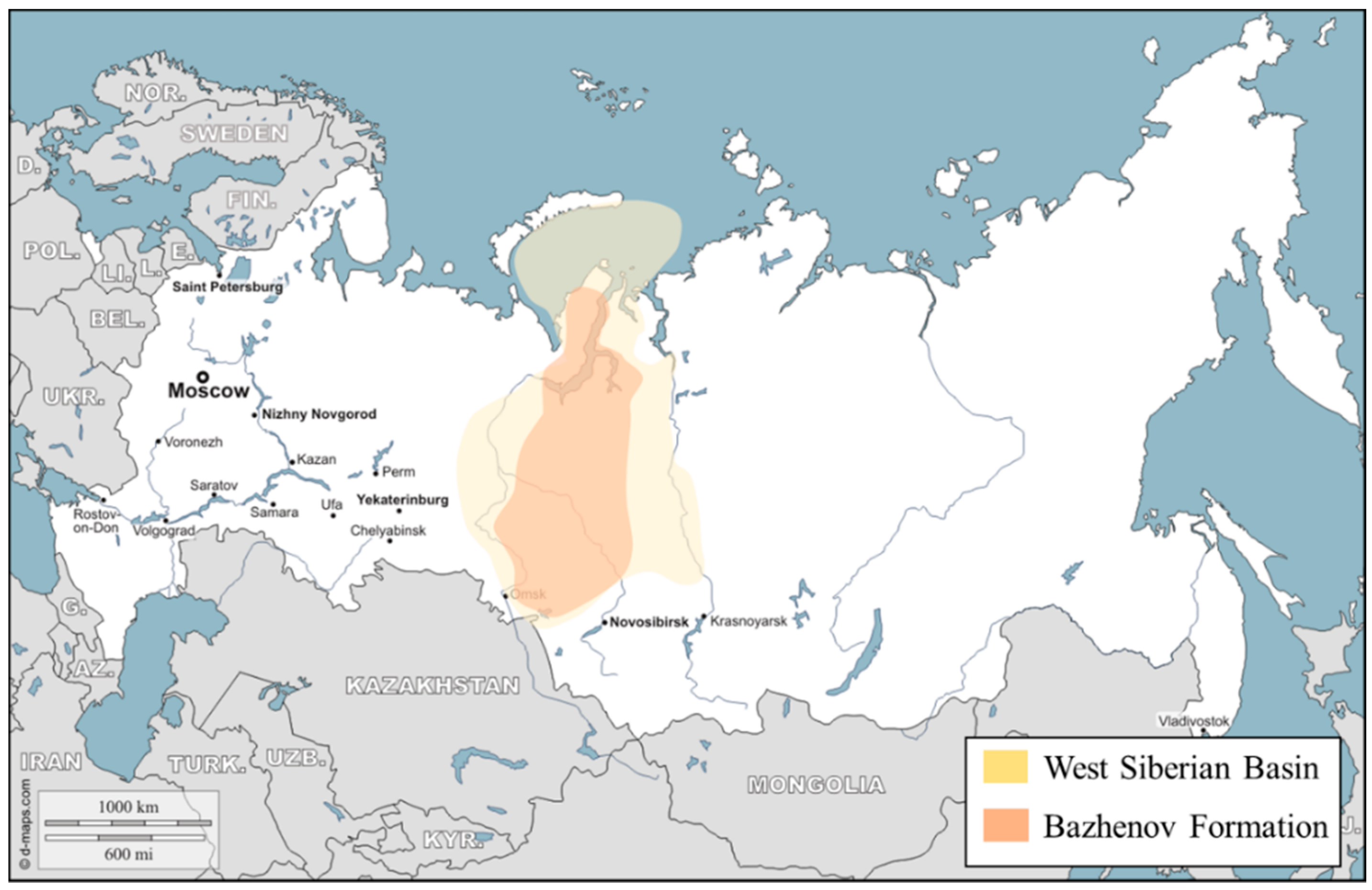
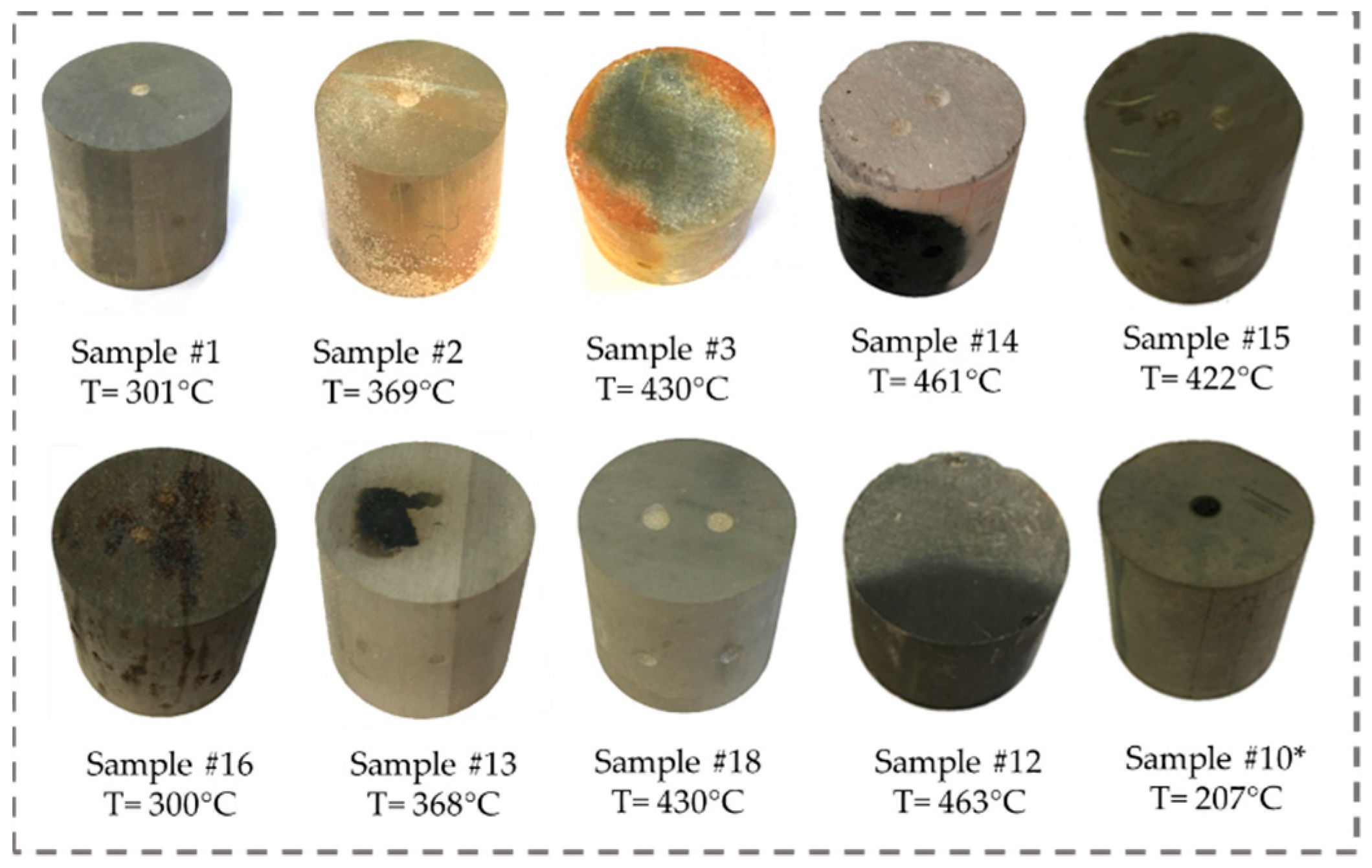


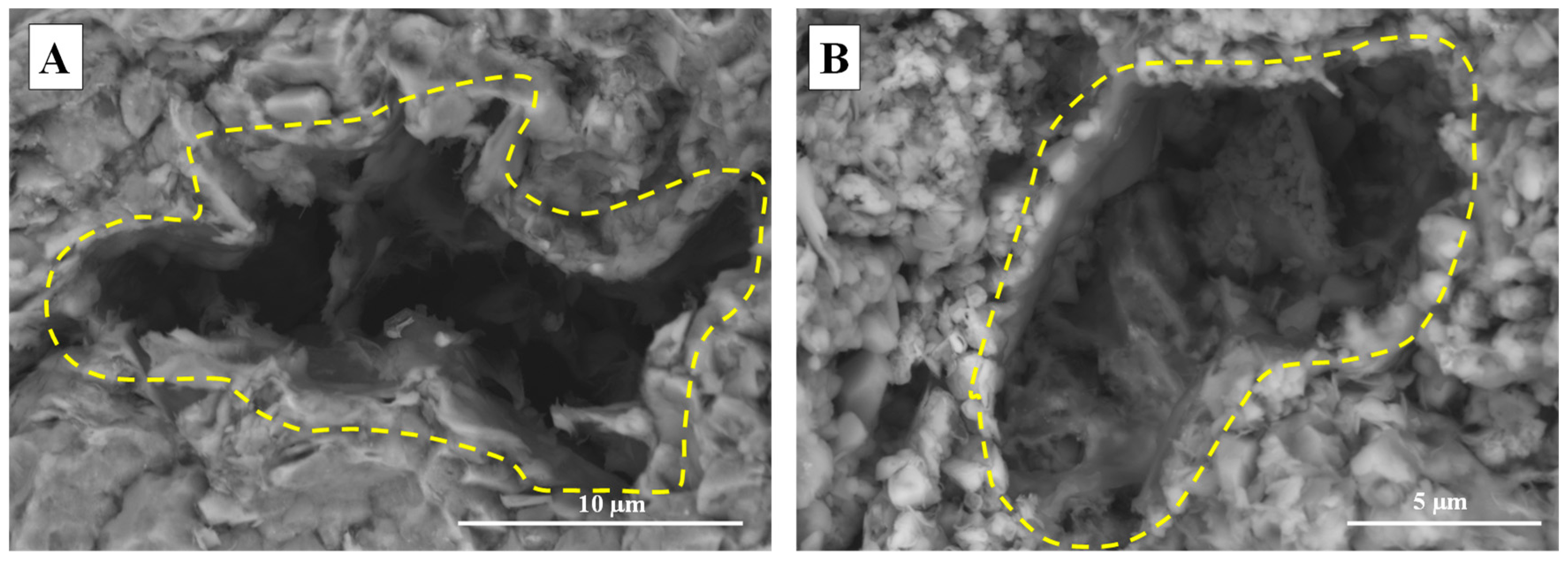




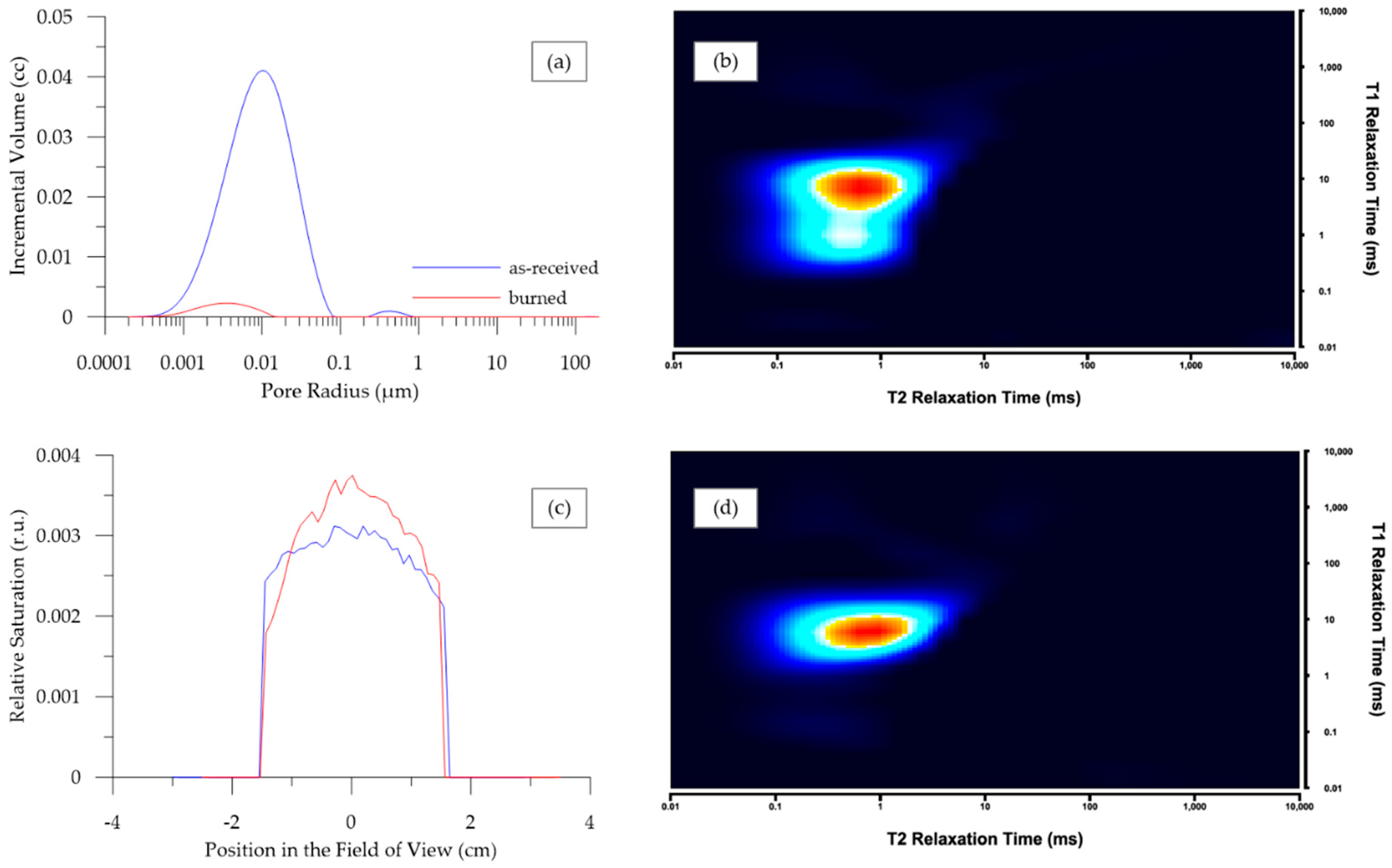

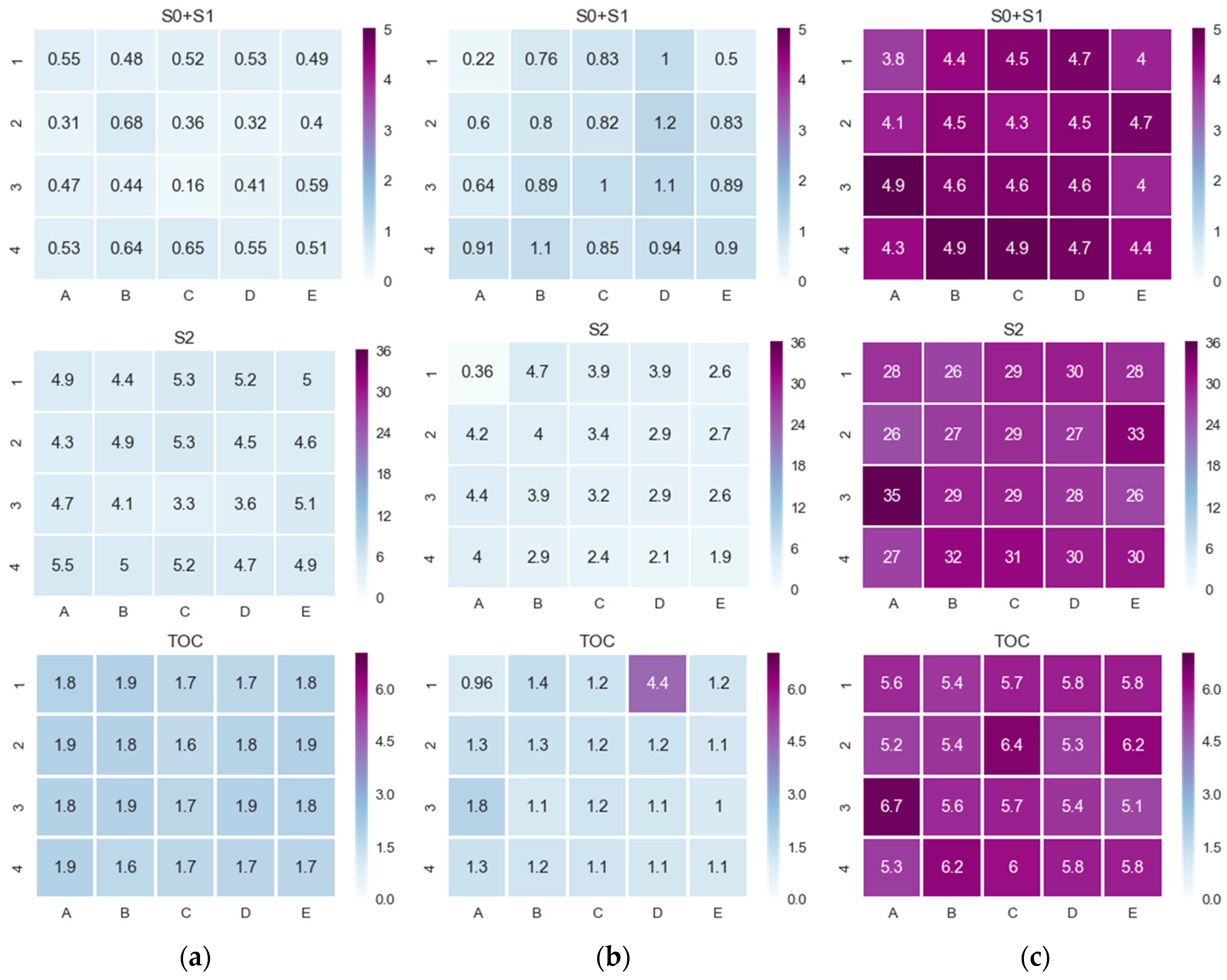
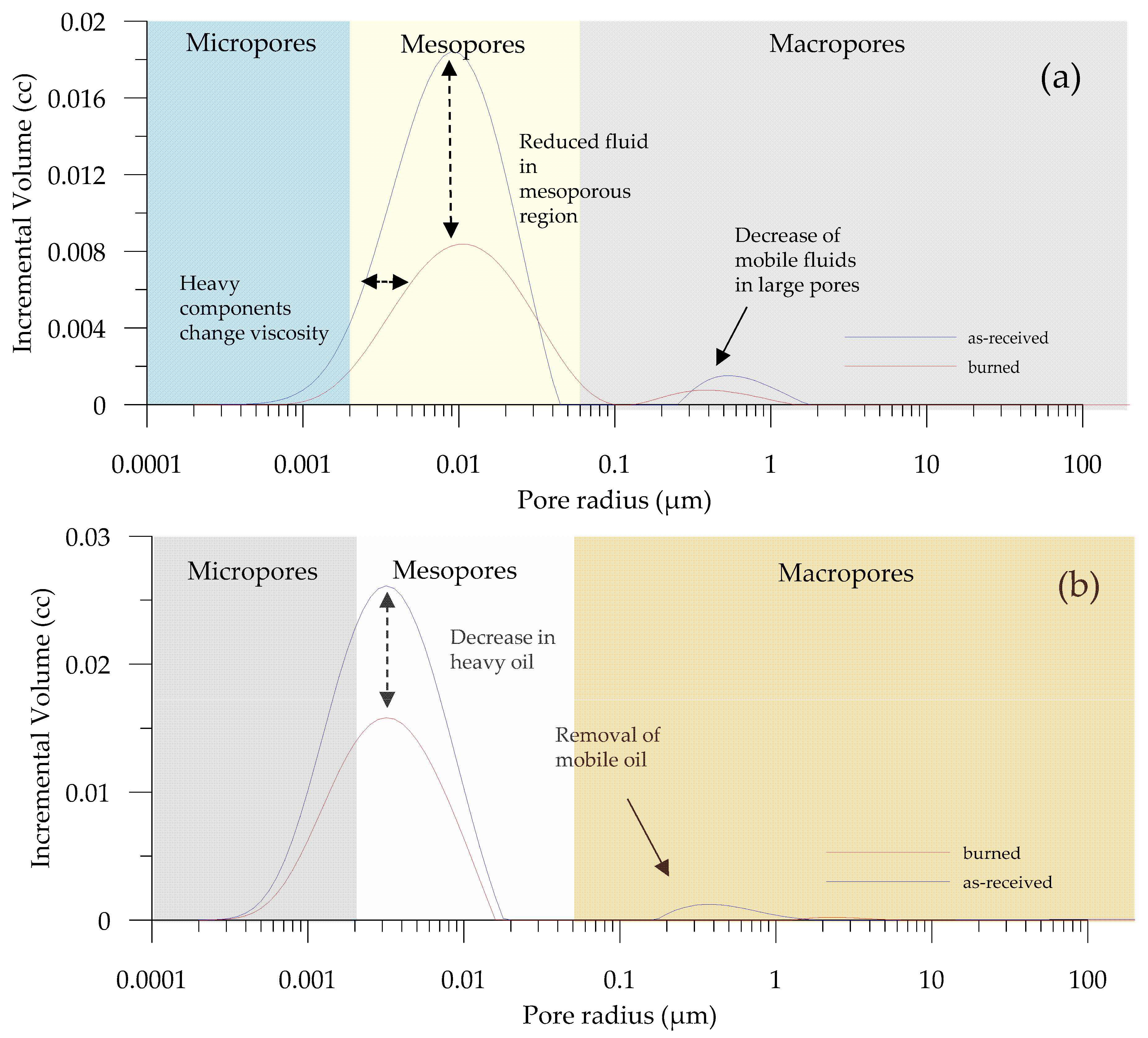
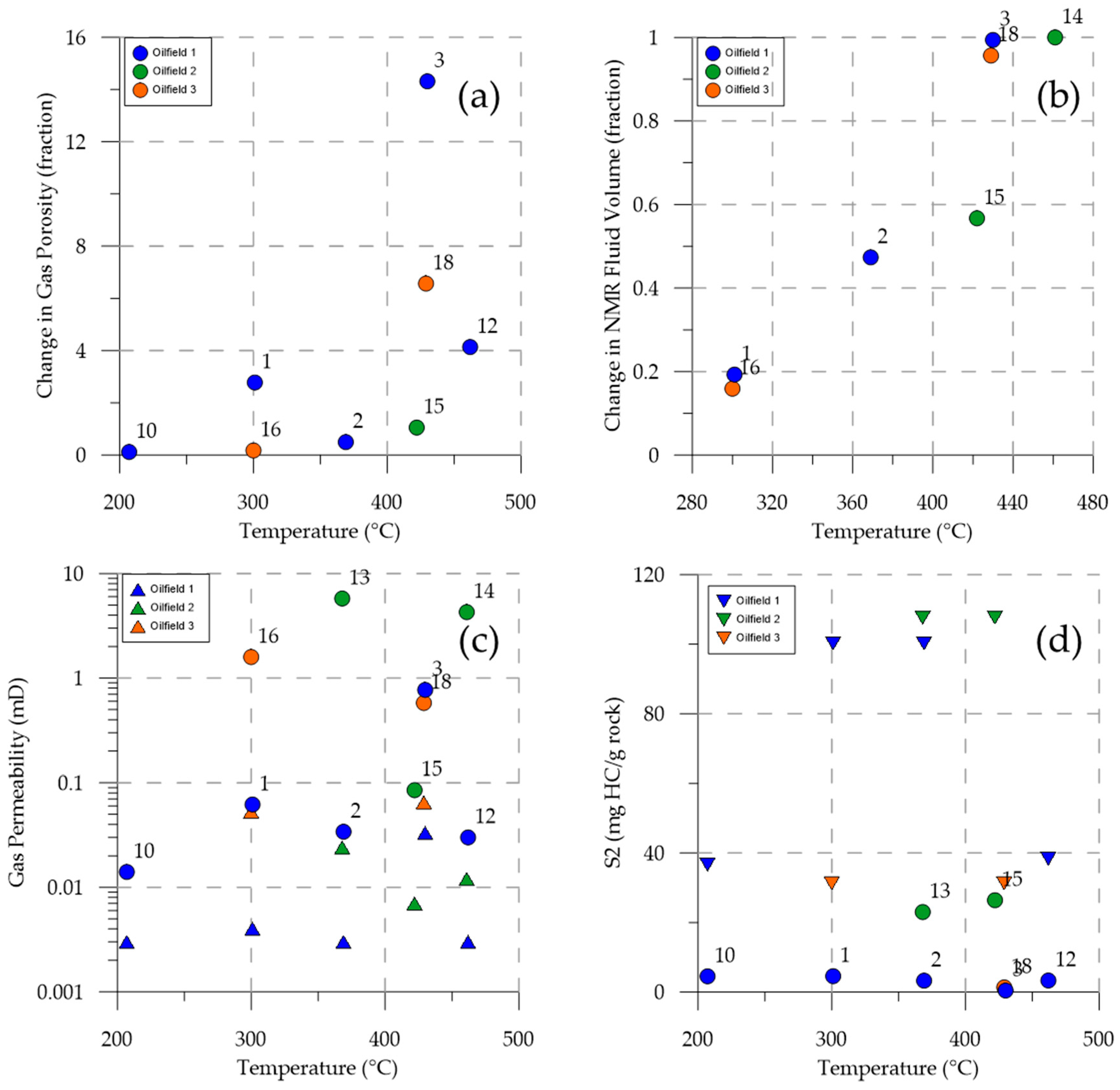
| Mineral Composition (%) | |||||
|---|---|---|---|---|---|
| Quartz | Clay Minerals | K Feldspar | Na Feldspar | Pyrite | Dolomite |
| 61.2 | 27.7 | 0.0 | 8.9 | 0.6 | 1.6 |
| Experiment | Sample | Objective |
|---|---|---|
| Porosity and permeability by gas | Cylinders, 30 × 30 mm | Change in porosity and permeability under different temperature exposure |
| NMR relaxometry | Cylinders, 30 × 30 mm | Evaluation of the change in saturation by NMR |
| Rock-Eval pyrolysis SEM | Core powder, 30 mg Core chip, 3 × 3 mm | Study of the OM transformation |
| Sample ID. | Oil Field | Lithology | CT Zone | Exposed Temperature (°C) |
|---|---|---|---|---|
| 1 | Oil Field 1 | Siliceous rocks | 2.1 | 301 |
| 2 | 2.2 | 369 | ||
| 3 | 3.1 | 430 | ||
| 10 | 6.1 | 207 | ||
| 12 | 4.1 | 463 | ||
| 13 | Oil Field 2 | Mixed argillaceous-siliceous rocks | 2.2 | 368 |
| 14 | 3.4 | 461 | ||
| 15 | 4.2 | 422 | ||
| 16 | Oil Field 3 | Siliceous rocks | 2.1 | 300 |
| 18 | 3.1 | 430 | ||
| n1, n2, n3, n4, n5 | Oil Field 4 | Mixed argillaceous-siliceous rocks | n/a | n/a |
| Sample ID | Section | Temperature (°C) | Porosity before CT (%) | Permeability before CT (mD) | Porosity after CT (%) | Permeability after CT (mD) |
|---|---|---|---|---|---|---|
| 1 | 2.1 | 300 | 1.07 | 0.004 | 4.04 | 0.062 |
| 2 | 2.2 | 368 | 1.28 | 0.003 | 1.91 | 0.034 |
| 3 | 3.1 | 430 | 0.54 | 0.033 | 8.27 | 0.769 |
| 10 | 6.1 | 207 | 0.95 | 0.003 | 0.84 | 0.014 |
| 12 | 4.1 | 462 | 1.41 | 0.003 | 7.24 | 0.030 |
| 13 | 2.2 | 368 | 0.58 | 0.024 | 26.07 | 5.770 |
| 14 | 3.4 | 461 | 0.47 | 0.012 | 31.92 | 4.277 |
| 15 | 4.2 | 422 | 0.62 | 0.007 | 1.27 | 0.085 |
| 16 | 2.1 | 299 | 2.81 | 0.053 | 3.30 | 1.591 |
| 18 | 3.1 | 429 | 2.43 | 0.065 | 18.39 | 0.577 |
| Avg. | 1.22 | 0.021 | 10.33 | 1.321 | ||
| SD | 0.81 | 0.02 | 11.18 | 2.04 |
| Sample ID | Oil Field | S1 | S2 | S3 | TOC | Tmax |
|---|---|---|---|---|---|---|
| mg HC/g Rock | mg HC/g Rock | mg CO2/g Rock | wt.% | °C | ||
| 1/2 | 1 | 3.96 | 100.2 | 0.34 | 14.01 | 424 |
| 10 | 1 | 1.41 | 36.65 | 0.39 | 6.01 | 429 |
| 12 | 1 | 0.63 | 38.36 | 0.24 | 5.39 | 428 |
| 13/15 | 2 | 6.30 | 107.6 | 0.2 | 16.98 | 433 |
| 16/18 | 3 | 6.95 | 31.26 | 0.31 | 7.98 | 446 |
| Avg. | 3.85 | 62.81 | 0.29 | 10.07 | n/a | |
| SD | 2.83 | 37.69 | 0.08 | 5.15 | n/a |
| Sample ID | Oil Field | S0 | S1 | S2 | S3 | TOC | Tmax |
|---|---|---|---|---|---|---|---|
| mg HC/g Rocks | mg HC/g Rocks | mg HC/g Rocks | mg CO2/g Rocks | wt.% | °C | ||
| 1 | 1 | 0.05 | 0.13 | 4.56 | 0.70 | 1.55 | 425 |
| 2 | 1 | 0.30 | 0.55 | 3.25 | 0.49 | 1.43 | 430 |
| 3 | 1 | 0.04 | 0.1 | 0.44 | 0.38 | 1.41 | 457 |
| 13 | 2 | 4.20 | 17.14 | 22.99 | 0.17 | 10.88 | 439 |
| 15 | 2 | 2.20 | 2.69 | 26.42 | 0.24 | 5.30 | 434 |
| 18 | 3 | 0.19 | 0.69 | 1.33 | 0.16 | 4.86 | 586 |
| Avg. | 1.16 | 3.55 | 9.83 | 0.36 | 4.24 | n/a | |
| SD | 1.70 | 6.73 | 11.66 | 0.21 | 3.71 | n/a |
| Sample ID | Before CT | After CT | ||||||
|---|---|---|---|---|---|---|---|---|
| Total Fluid Volume (cc) | Bitumen & Adsorbed Oil (%) | Structural & Adsorbed Water (%) | Mobile Oil in IP (%) | Total Fluid Volume (cc) | Bitumen & Adsorbed Oil (%) | Structural & Adsorbed Water (%) | Mobile Oil in IP (%) | |
| 1 | 0.42 | 84.22 | 8.40 | 5.34 | 0.33 | 86.45 | 8.13 | 5.96 |
| 2 | 0.34 | 86.29 | 6.45 | 6.72 | 0.17 | 68.86 | 26.75 | 5.26 |
| 3 | 0.32 | 82.14 | 7.65 | 8.16 | 0.002 | 31.72 | 13.10 | 18.62 |
| 10 | - | - | - | - | 0.49 | 28.78 | 64.39 | 7.19 |
| 12 | - | - | - | - | 0.28 | 44.74 | 41.67 | 10.53 |
| 14 | 1.14 | 93.83 | 2.53 | 2.02 | 8·10−8 * | n/a | n/a | n/a |
| 15 | 0.76 | 77.68 | 16.19 | 11.23 | 0.32 | 81.20 | 2.87 | 14.36 |
| 16 | 0.86 | 59.98 | 42.18 | 4.54 | 0.03 | 85.84 | 7.77 | 5.18 |
| 18 | 0.90 | 59.25 | 41.09 | 5.12 | 0.72 | 0 | 20.83 | 0 |
| Avg. | 0.68 | 77.63 | 17.78 | 6.16 | 0.29 | 53.45 | 23.19 | 8.39 |
| SD | 0.32 | 13.23 | 16.80 | 2.93 | 0.24 | 31.98 | 20.83 | 5.89 |
Publisher’s Note: MDPI stays neutral with regard to jurisdictional claims in published maps and institutional affiliations. |
© 2020 by the authors. Licensee MDPI, Basel, Switzerland. This article is an open access article distributed under the terms and conditions of the Creative Commons Attribution (CC BY) license (http://creativecommons.org/licenses/by/4.0/).
Share and Cite
Mukhametdinova, A.; Mikhailova, P.; Kozlova, E.; Karamov, T.; Baluev, A.; Cheremisin, A. Effect of Thermal Exposure on Oil Shale Saturation and Reservoir Properties. Appl. Sci. 2020, 10, 9065. https://doi.org/10.3390/app10249065
Mukhametdinova A, Mikhailova P, Kozlova E, Karamov T, Baluev A, Cheremisin A. Effect of Thermal Exposure on Oil Shale Saturation and Reservoir Properties. Applied Sciences. 2020; 10(24):9065. https://doi.org/10.3390/app10249065
Chicago/Turabian StyleMukhametdinova, Aliya, Polina Mikhailova, Elena Kozlova, Tagir Karamov, Anatoly Baluev, and Alexey Cheremisin. 2020. "Effect of Thermal Exposure on Oil Shale Saturation and Reservoir Properties" Applied Sciences 10, no. 24: 9065. https://doi.org/10.3390/app10249065
APA StyleMukhametdinova, A., Mikhailova, P., Kozlova, E., Karamov, T., Baluev, A., & Cheremisin, A. (2020). Effect of Thermal Exposure on Oil Shale Saturation and Reservoir Properties. Applied Sciences, 10(24), 9065. https://doi.org/10.3390/app10249065






